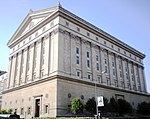Pittsburgh Quantum Institute

The Pittsburgh Quantum Institute (PQI) is a multidisciplinary research institute that focuses on quantum sciences and engineering in the Pittsburgh region. It is a research-intensive cluster. The Pittsburgh Quantum Institute (PQI) was founded in 2012 with the mission “to help unify and promote quantum science and engineering in Pittsburgh”. With financial support from the Dietrich School of Arts and Sciences at the University of Pittsburgh, PQI provides leadership throughout Pittsburgh in areas that impact the “second quantum revolution”. PQI members have faculty appointments from Duquesne University, Carnegie Mellon University, and the University of Pittsburgh in physics, chemistry, and engineering disciplines. The Pittsburgh Quantum Institute currently consists of 100 professors and their groups, a number that keeps growing every year with faculty appointments in the various departments of the member institutions. PQI sponsors and organizes research seminars, panel discussions, public lectures, and outreach activities, and a signature event (PQI20XX in April) that brings in a dozen plenary speakers and a public lecture. PQI supports graduate students with research and travel awards, and sponsors two well-attended poster sessions per year. The PQI website (www.pqi.org) highlights research and researchers, hosts multiple videos, and provides a regular feed of information relevant to the PQI community. PQI also coordinates with other important centers and facilities (Pittsburgh Supercomputing Center, Petersen Institute for Nanoscience and Engineering, Carnegie Mellon University Nanofabrication Facility, and the Center for Research Computing).
Excerpt from the Wikipedia article Pittsburgh Quantum Institute (License: CC BY-SA 3.0, Authors, Images).Pittsburgh Quantum Institute
Fifth Avenue, Pittsburgh
Geographical coordinates (GPS) Address Nearby Places Show on map
Geographical coordinates (GPS)
| Latitude | Longitude |
|---|---|
| N 40.444565 ° | E -79.953274 ° |
Address
Cathedral of Learning
Fifth Avenue 4200
15260 Pittsburgh
Pennsylvania, United States
Open on Google Maps








